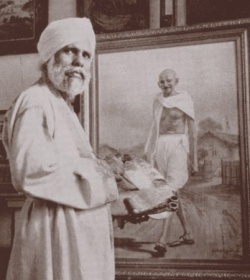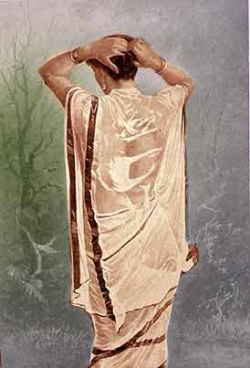S G Thakur Singh
S.G. Thakur Singh (1899 - 1976) was born in 1899 at Verka, a tiny, insignificant village four miles from Amritsar, Punjab, India. He never had proper education owing to his poor family circumstances. His heart being set upon painting and drawing from a very early age, he apprenticed himself to Mohammed Alam, a local skilled Mohammedan painter of some repute. From Alam he learnt the rudiments of the art; later he accompanied Mohammed Alam to Bombay where the latter had secured a job as a stage painter in a certain theatrical company.
In 1917, when he was just 18 years old, he was awarded a cash prize of Rs. 500 at an exhibition held at Simla. This was the beginning of a fruitful life which thrust the simple Punjabi village boy to world fame. He worked for various theatrical companies in Calcutta; it became apparent that he would excel as a painter.
Following long hours of hard work both in Bombay and Calcutta, his talents were recognised by famous world personalities; the demand for his work increased and Singh's work began appearing in famous art galleries and at exhibitions.
Early life
The village school could not absorb all his energies. He roamed the fields and watched the cowherds and their flocks, and the maidens draw water from the village well. This is how Verka nurtured the boy who grew to be one of India’s most outstanding painters. But his gifts were then latent. Only the Muslim teacher of the village, Mohammad Alam, knew that he had those gifts.
Alam encouraged him and showed that the simple lines that he drew to suggest a tree or the sky or a maiden could be improved thus. To quote him “I was forced by my guardians to join Victoria Diamond Hindu Technical Institute, Lahore, to take up an engineering course. I wasted there two years and left it in disgust.” He was not quite eighteen yet.
Adventure in Bombay
His relations gave up hope but not so Mohammad Alam! When young Thakur Singh returned home, he persuaded Singh to join him in an adventure. Mohammed Alam had secured a job as a scene-painter in Bombay theatre. There the village lad worked both at odd jobs in the studio and on his own; Alam guiding him.
“One fine morning”, recalls the seventy four years old artist. “I was busy with doing a landscape at Chowpati Sea Beach when a couple suddenly stopped beside me and began admiring my painting which was, by that time, almost complete. The gentlemen, an influential Parsi editor of a Bombay Magazine, goaded me into sending the painting to an exhibition of the Simla Fine Arts Society. My painting won the first prize of Rs. 500/- among the landscapes. I was then only eighteen, and you can well imagine my job and pride at getting the prize”.
Recognition for his work
Just as that chance encounter on Chowpati Beach led to his first prize in the painting; throughout his life he has won and retained the friendship of many worthy patrons.
Dr. Rabindra Nath Tagore, Dr. Rajendra Prasad, first president of Indian Republic, Dr. Radha Krishanan and artists and critics of such international renown as Nicholas Roreich and Gerasimov, President of the U.S.S.R., Academy of Arts, J.P. Gangoly and many others have paid tribute to his work.
From Bombay to Calcutta
From Bombay he moved to Calcutta and it was here that S.G. Thakur Singh realized that he must raise the artistic level of the Punjab. Accordingly, with the co-operation of friends, he organized "The Punjab Fine Arts Society" in Calcutta and the Society’s first Exhibition was held in 1926.
Subsequently, he organized an Art Academy in Amritsar - "Indian Academy of Fine Arts". He brought into being The Thakur Singh School of Art, Amritsar. Its record is very creditable and several of its past students are now achieving recognition as artists or as art-teachers and it has been lately recognized by the Industrial Training Department of the Punjab Government to award diploma of Art & Craft, teacher's course.
His paintings and Awards
He painted in oils, pastels and water color. His job at the theatre was routine work but he sought no leisure and drove himself hard. Thus between his winning that first prize at the Simla Exhibition and his return to Amritsar in 1933, he had painted nearly ten thousand pictures. His painting “After the Bath” won the second prize of ₤800 at the British Empire Exhibition in London in 1924.
Ten years later at the Exhibition of Modern Indian Art, held in London and opened by the Duchess of York (now the Queen Mother) on December 30, 1934, his painting entitled “Ganesh Puja” which depicts a typical statuesque Maharashtrain Lady offering Puja before the idol of Ganesha and later bought by Mr. M.S. Aney, created a sensation.
Commissions and fame
Among his princely patrons have been the late Maharaja of Udaipur who commissioned two hundred paintings; the late Nawab of Bhopal who commissioned one hundred paintings and the Maharaja of Kashmir, Dongarpur, Travancore, Nawanagor, Kotah, Bikaner, Kapurthala, Patiala and other States. Lord Irwin (later Lord Halifax) and Lord Linlithgow, each became the owner of Thakur Singh’s paintings “Eveninig Lights on the Old Palace, Udaipur” and “Valley of Gulmarg” respectively.
The President’s residence (Rashtrapati Bhawan) in New Delhi has given a place of honor to his impressive painting depicting the assumption of office by the first Indian Governor General Sri C. Rajagopalachari. S.G. Thakur Singh had also the privilege of painting a portrait of late Dr. Rajinder Prasad who honored both the artist and Amritsar by inaugurating the silver Jubilee Exhibition of the Academy of fine Arts on the 30th October, 1953.
The beautiful painting “Her Last Desire” which was acquired by the Government of the U.S.S.R. hangs in the National Art Gallery, Moscow. The Scottish National Gallery bought his painting of the Qutab Minar, Delhi.
Honoured and Recognised
The country has honored him in other ways too. He was nominated to the First Punjab Legislative Council in the year 1952. He is represented on the Executive Board of the National Academy of Art (Lalit Kala Akademy) and was Chairman of the Decoration Sub Committee at the 61st Session of the Indian National Congress held at Amritsar in 1956.
It is the wish of the admirers that he should be nominated to the Rajya Sabha (The House of elders) to represent Art. He was invited to U.S.S.R. and Hungary to hold his one man shows of paintings in the principal cities of these countries i.e. Moscow, Leningrad and Budapest.
The best of his figure studies is “After the Bath” showing a well–proportioned woman (as seen from back) adjusting her hair after the bath. Her wet clothes still cling to her body. We shall not ask the artist how he managed to get a get a model on whom the wet clothes remained wet while he painted, or whether it was a series of sittings, each time the young woman coming from her bath to pose. Owned by the Maharaja of Patiala “After the Bath” will be hailed by generations to come and may even be classed with Ingres’s famous painting “La Scurce”.
Commissioned portraits are necessary for all portrait painters for these earn them their bread and butter. But not all sitters inspire the artist. This is a part of the portrait painter’s lot whether he be Sir Gerald Kelly or S.G. Thakur Singh. But his portraits, irrespective of the importance of the subject, have all been painted seriously.
Dedication and popular acclaim
The other portrait is that of the artist’s wife. Its subdued tones convey the emotions which the artist must have felt when he painted her. It is his landscapes which have won for him popular acclaim. These are many. Each is careful composition. Again that love for what has caught his eye and fired his imagination is there whether it be “The valley of Ladakh”or “The Chopatti Beach, Bombay” or “The Victory Tower of Chittor” or “The Taj Mahal”.
The Taj Mahal is the most photographed, the most painted monument. S. G. Thakur Singh has painted two aspects of The Taj Mahal. One entitled “Her Last Desire”, is the world famous tomb by evening light; the other entitled “Tear Drops” is the Taj Mahal by moonlight. Each has its distinctive mood and evokes the same in the beholder. These studies of the Taj Mahal are the best that I have seen.
While it is the tribute to Indian Art that the U.S.S.R should have acquired “Her Last Desire”, it is a pity that India’s own national Gallery of Art allowed it to go. All his landscapes have one common characteristic. They are all clear, sharply outlined shapes. Nothing is blurred for the sake of effect or through lack of competence as is the case of many artists. Substance is substantial enough to be touched and felt. Light is ethereal enough to be real light. This is S. G. Thakur Singh’s secret.
External links
- Sardar S.G.Thakur Singh - a very accomplished artist from the plains of Punjab
- Government Museum and Art Gallery, Chandigarh, India


